Understanding and Calculating Spring Flow
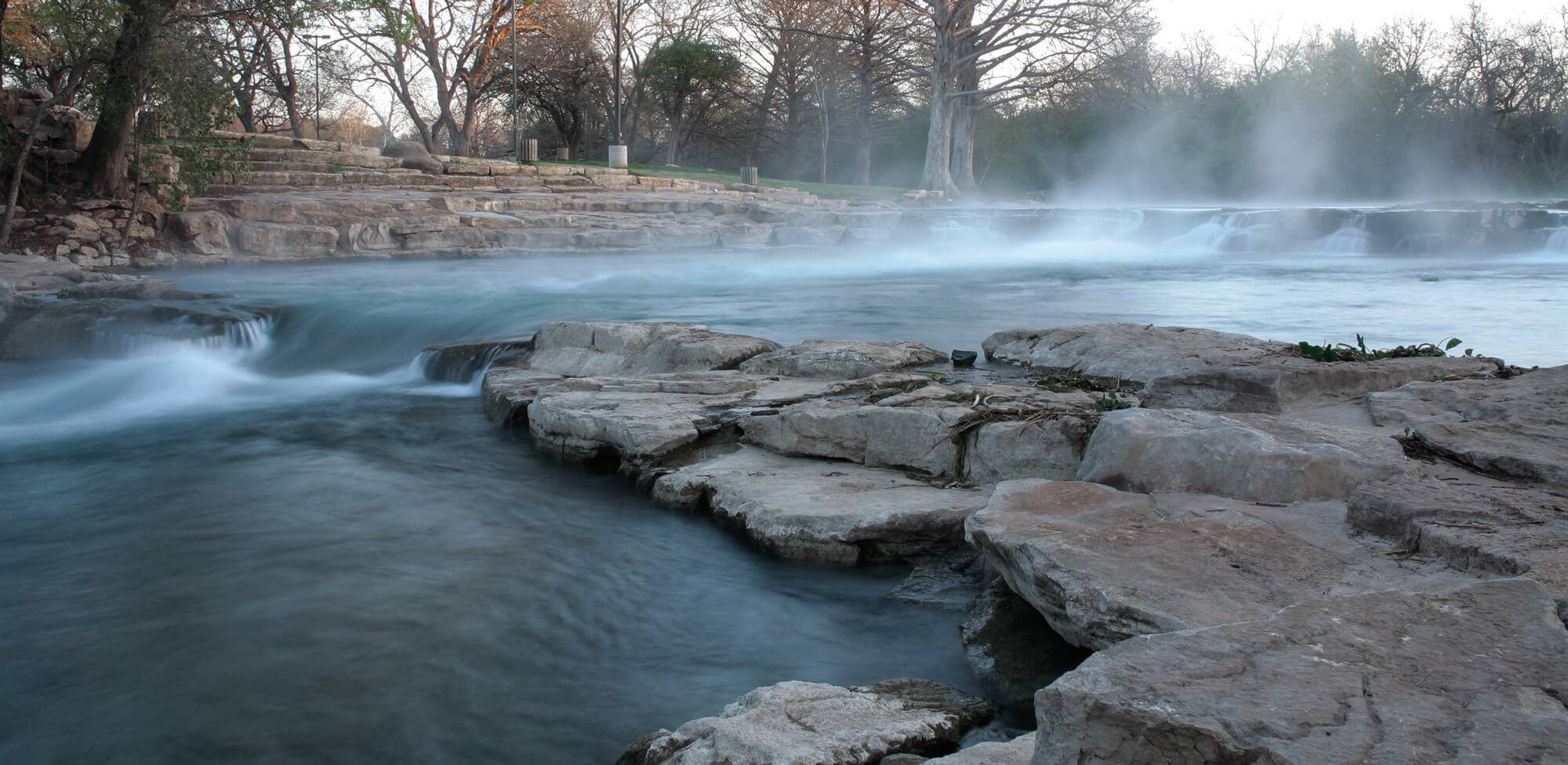
Quick Glance at the Edwards Aquifer
-
What is the Edwards Aquifer?
The Edwards Aquifer (a naturally occurring subsurface reservoir capable of storing and yielding significant quantities of water) is one of the most permeable and productive sources of potable groundwater in the world. This karst aquifer is named for the Edwards Group—a collection of relatively soluble limestone and dolomitic strata deposited in warm, shallow seas that dominated the central Texas landscape about 60-100 million years ago during the Cretaceous Period.
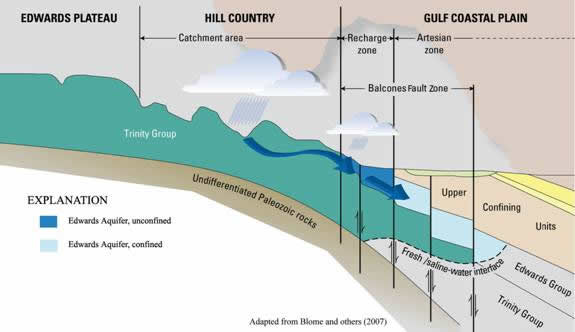
The Edwards Aquifer is recharged primarily through leaky streambeds atop the porous outcrop of the Edwards Group along the northern margin of Balcones Fault Zone (a complex system of geologic faults and fractures). Here, surface-water runoff from the Catchment area—together with incident precipitation—enters the Recharge zone of the aquifer through faults, fractures, sinkholes, and caves. The Edwards Aquifer is recharged also by lateral, subsurface inflow across the northern limits of the fault zone where the up-gradient Trinity Group is juxtaposed against the down-faulted Edwards Group.Recharge through stream bed leakage and precipitation on the aquifer’s outcrop is estimated to have ranged from nearly 44,000 acre-feet (during 1956) to almost 2,500,000 acre-feet (1992) and to have averaged about 730,000 acre-feet per year since 1934. The amount of recharge occurring as lateral, subsurface inflow from the Trinity Aquifer is estimated to range from less than 25,000 to perhaps 64,000 acre-feet per year. Two-thirds of all Edwards Aquifer recharge occurs west of San Antonio. The remaining one-third enters through up-dip, unconfined parts of the aquifer in Bexar, Comal, and Hays counties.
Reference: Blome, C.D., J.R. Faith, and G.B. Ozuna, 2007, Geohydrologic framework of the Edwards and Trinity aquifers, south-central Texas: U.S. Geological Survey Fact Sheet 2006-3145, 6 p, http://pubs.usgs.gov/fs/2006/3145/The entire Edwards (Balcones Fault Zone) Aquifer extends along the narrow belt of Balcones Fault Zone from the north of Georgetown through Austin, San Marcos, New Braunfels, San Antonio, Hondo, Sabinal and Uvalde to Brackettville. This limestone aquifer is separated into three portions by groundwater divides at Kyle in Hays county and at the Colorado River. The central portion, from Kyle to Colorado River is referred to as the Barton Springs segment.
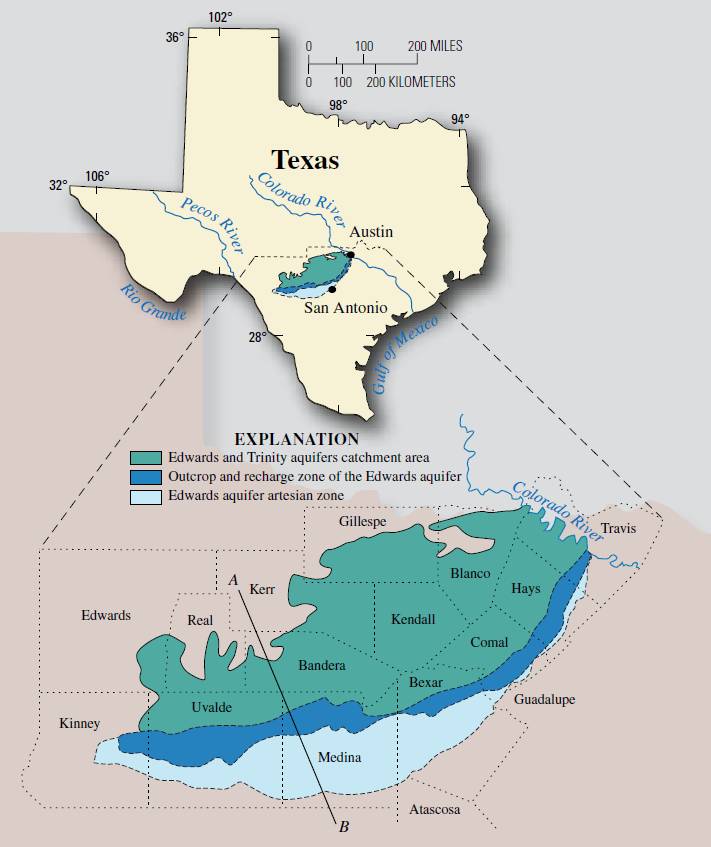
Edwards Aquifer -Balcones Fault (U.S. Geological Survey Fact Sheet 2006-3145) A major problem facing the Edwards Aquifer is the threat of overdrafting the average annual recharge and maintaining natural spring flows. Accordingly, the Edwards Aquifer Authority (EAA) was authorized by the state legislature to develop, implement, and enforce a Critical Management Plan (CMP). The Cities of San Antonio, New Braunfels, and San Marcos have had to enforce Water Conservation Plan ordinances and water use disputes among aquifer users have become more frequent. In the most current case, the Sierra Club sued the Secretary of the Interior and the U.S. Fish and Wildlife Service (FWS) for failure to perform duties under the Endangered Species Act (ESA) and for injunctive relief. The U. S. District Court for the Western District of Texas reached a decision on January 30, 1993, and ordered FWS to determine required spring flows, and the Texas Water Commission (TWC, now the Texas Natural Resource Conservation Commission or TNRCC) to prepare a plan assuring spring flows will not drop below jeopardy levels. The court threatened additional orders if the State Legislature did not set up a regulatory system to limit withdrawals from the aquifer. In response, the 73rd Texas Legislature passed the Senate Bill No. 1477 to create the Edwards Aquifer Authority (EAA) and abolish the Edwards Underground Water District (EUWD), effective September 1, 1993. Governed by an appointed Board of Directors, the authority's primary function is to regulate the aquifer pumpage by limiting the long-term annual withdrawal at 400,000 ac-ft. The limiting amount is believed to be adequate to maintain the spring flows at the Comal and the San Marcos, although the court opinion stated this level to be 200,000 ac-ft. Aquifer modeling on a monthly basis is a part of the effort to improve the understanding of the quantitative relationship among recharge, pumpage, spring flow, and water levels. Such models will allow efficient and prudent management options to be explored without actually implementing the plan that would cause take or jeopardy of federally-listed species. The headwaters of the San Marcos River (San Marcos Springs), average flow 160 cubic feet/second or approximately 100 million gallons per day.
The Edwards Aquifer is approximately 160 miles long measuring from Brackettville to Kyle and varies in width from 5 to 40 miles. It extends to cover the major part of five counties namely, Uvalde, Medina, Bexar, Comal and Hays. It traverses several streams in three major river basins including the Nueces, San Antonio and Guadalupe. The aquifer is a very unique carbonate aquifer located in south-central Texas. Karst characteristics of the Edwards Aquifer make it one of the most productive aquifers in the United States and yet groundwater flow within the aquifer is very complex and difficult to predict. The Edwards Aquifer is designated by the EPA as a "sole source" drinking water supply for the 1.7 million people of San Antonio and the Austin-San Antonio corridor. The aquifer is also vital to the agricultural and light industrial economy of the region. Spring flows from the Comal and San Marcos Springs provide water for the tourist and recreation industry, critical habitat of several endangered species, appropriated water use downstream on the Gulf Coastal Plain, and the San Antonio Bay ecosystem.
-
Hydrology
The chart below shows the stratigraphic units of a typical Edwards Aquifer cross section. The aquifer is an association of Early Cretaceous age limestones overlying the Glen Rose Limestone and underlying the Del Rio Clay. The base of the aquifer is confined by the upper part of the Glen Rose Formation and in the artesian section, the top of the aquifer is confined by the Del Rio Formation. The lateral boundaries of the Edwards Aquifer consist of groundwater divides on the east and west near Kyle in Hays County and near Brackettville in Kinney County, respectively. The aquifer is bounded on the south by the "bad water line", (line marking water with more than 1000 mg/l of total dissolved solids), and on the north by the northern most edge of the Balcones Fault Zone.
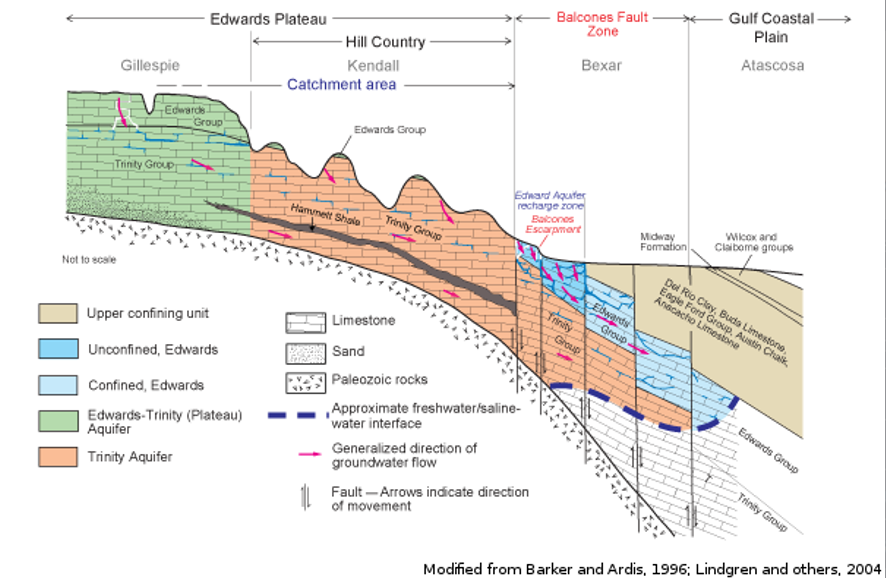
The Edwards Group and associated limestones were deposited as shallow marine platform carbonates consisting of reef and deep marine lithofacies in the western portion of the aquifer region. Most of the Edwards Group and associated limestones within the San Marcos Platform and the Devils River Reef Trend were subjected to subaerial exposure after deposition which enhanced the development of secondary porosity (Maclay and Land, 1988). Enhanced porosity has also occurred along the high angle faults and fractures of the Balcones Fault Zone.

Edwards Aquifer - Balcones Fault (TWDB interactive map)
The Edwards Aquifer receives water primarily from streams and rivers originating from the catchment areas on the Edwards Plateau. Except for the Guadalupe River, all streams and rivers that cross the outcrop of the Edwards Aquifer lose major portions of their flow to the aquifer through joints, faults, and sink holes. There are three river basins that cross the aquifer area: the Nueces, the San Antonio, and the Guadalupe River. Extending from the west, the Nueces River Basin covers over a half of the aquifer area. Several major tributaries in the basin traverse the aquifer recharge zone including the Nueces; the West Nueces; the Frio; the Dry Frio; the Sabinal Rivers; the Seco; and the Hondo Creeks. The portion of the San Antonio River Basin that is located in the recharge zone extends from the Medina River to the Cibolo Creek and includes headwaters of the Helotes, Leon, and Salado Creeks. Only a small portion of the Guadalupe River Basin intersects the eastern aquifer area. However, two of the basin tributaries, the Comal and San Marcos Rivers, are primarily fed by the aquifer at the Comal and San Marcos Springs. The tributaries crossing the recharge area include the Guadalupe River, the Blanco River, and headwaters of the Comal and San Marcos Rivers. Small creeks in the headwaters are the Dry Comal, Alligator, York, Purgatory, and Sink Creeks.
Based on the USGS estimates, the aquifer has an average annual recharge of 651,700 ac-ft with about 58.5% contributed by the Nueces River Basin. Generally, the water flows south-southeastward from the recharge zone under steep hydraulic gradients and low permabilities within the unconfined portion of the aquifer. As the water flows into the confined portion of the aquifer, the flow direction changes toward the east and northeast within the low gradient, highly permeable grabens in the artesian zone. The water then discharges from several springs -- mostly the Comal and San Marcos Springs -- which account for 355,500 ac-ft annually. The two major springs contribute about 25% of flow in the Guadalupe River downstream. The contribution was about 66% during the drought year of 1956.
An excellent reference entitled the, Balcones Escarpment contains papers by EARDC staff Longley and Ogden that provide interesting information regarding the aquifer. This reference also has several other illustrated papers about the aquifer.
Local Threatened and Endangered Species
All of the forms of life living in the aquifer (groundwater system) have adapted to this existence by being colorless and eyeless. They often have other senses highly developed. All evidence to date indicates that the subterranean aquatic ecosystem of the aquifer is the most diverse groundwater ecosystem known in the entire world.
-
Texas Blind Salamander

The Texas Blind Salamander, Typhlomolge rathbuni is the top carnivore in the Hays County area of the San Antonio segment of the Balcones Fault Zone Edwards Aquifer. Listed by both the State of Texas and the Federal government as endangered.
-
San Marcos Salamander
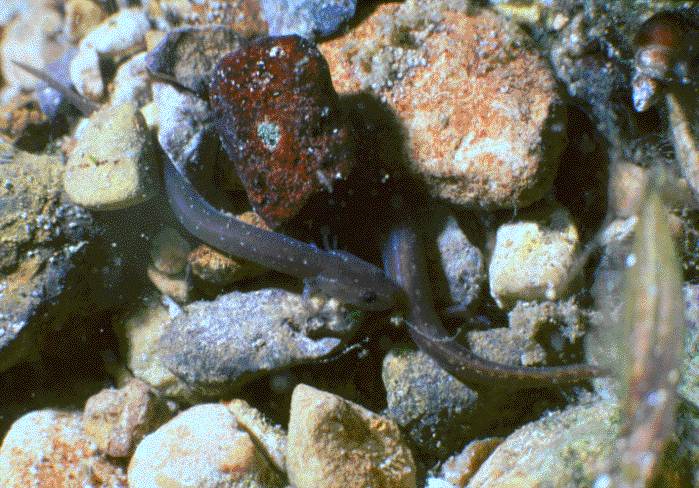
The San Marcos Salamander, Eurycea nana is found only in the spring run of San Marcos Springs. Listed by both the State of Texas and the Federal government as threatened.
-
Fountain Darter

The Fountain Darter, Etheostoma fonticola is found in the spring runs of Comal and San Marcos Springs. These springs flow from the aquifer and will dry if the aquifer levels are not maintained above the lips of the springs. Listed by both the State of Texas and the Federal government as endangered.
-
Texas Wild Rice
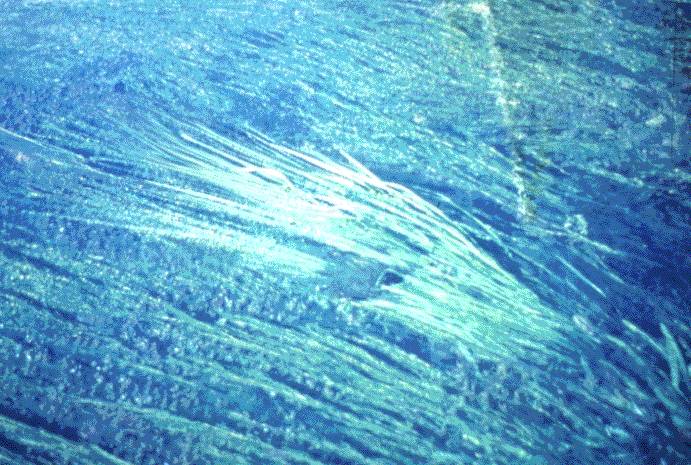
Texas Wildrice (Zizania texana) is found in the spring run of San Marcos Springs. Listed by both the State of Texas and the Federal government as endangered.
-
San Marcos Gambusia

The San Marcos Gambusia, Gambusia georgei has been found in the springrun of the San Marcos Springs. Listed by both the State of Texas and the Federal government as extinct.
-
Blanco Blind Salamander
The Blanco Blind Salamander, Typhlomolge robusta is found in the portion of the Edwards Aquifer north and east of the Blanco River. It closely resembles the Texas Blind Salamander, but has a more robust body with shorter, stouter legs. Listed by the State of Texas as endangered.
-
Comal Blind Salamander
The Comal Blind Salamander, Eurycea tridentifera is found only in the subterranean waters of several caves located within the Cibolo Creek flood plain in Comal and Bexar Counties. Resembles the Texas Blind Salamander, but has shorter legs and the snout is not as flattened. Eyes are buried beneath the skin. Listed by the State of Texas as threatened.
-
Comal Springs Riffle Beetle

Photo courtesy of Jean Krejca The Comal Springs Riffle Beetle, Heterelmis comalensis (larva at top, adult at bottom), is found in the gravel substrate in the surface waters of Comal Springs (Comal County) and San Marcos Springs (Hays County). Listed by the Federal government as endangered.
-
Comal Springs Dryopid Beetle
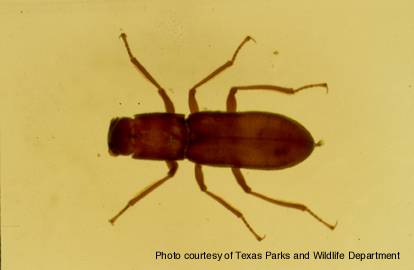
The Comal Springs Dryopid Beetle, Stygoparnus comalensisis the first subterranean aquatic dryopid beetle to be discovered. This beetle is eyeless and very weakly-pigmented. It inhabits the water of the Edwards Aquifer. Specimens have been collected from Comal Springs in Comal county and Fern Bank Spring located in Hays county. It may be confined to small areas around these springs, as no specimens have been collected from other locations in the aquifer. Listed as endangered by the Federal government.
-
Peck's Cave Amphipod
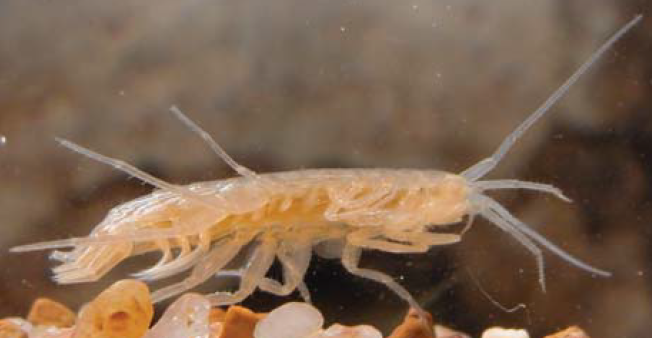
Photo courtesy of Jean Krejca Peck's Cave Amphipod, Stygobromus pecki is a subterranean aquatic crustacean that inhabits the waters of the Edwards Aquifer. It has only been collected at Comal Springs and Hueco Springs ( about 4 miles north of Comal Springs) in Comal county. It may be confined to small areas around these springs, as no specimens have been collected from other locations in the aquifer. Listed by both the State of Texas and the Federal government as endangered.
-
Austin Blind Salamander

Photo courtesy of Tom Devitt The Austin Blind Salamander, Eurycea waterlooensis is an endangered species which is endemic to Barton Springs area.
-
Barton Springs Salamander

Photo courtesy of USFWS The Barton Springs Salamander, Eurycea sosorum is found among the rubble in the spring outflow of Barton Springs in Austin (Travis County). Listed by the Federal government as endangered.
-
Toothless Blindcat & Widemouth Blindcat

The Toothless Blindcat, Trogloglanis pattersoni is found only in the Bexar Co. area of the San Antonio section of the aquifer. It is found in wells from 1350 feet deep to 2,000 feet deep. It is listed by the State of Texas as threatened.
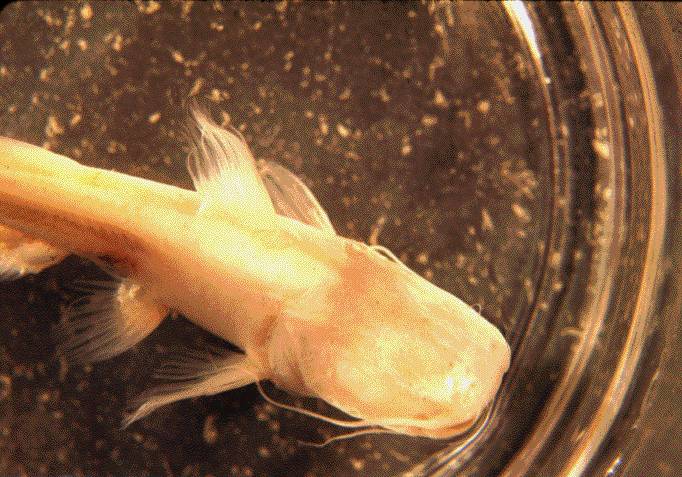
The Widemouth Blindcat, Satan eurystomus is found only in the San Antonio section of the Aquifer, under Bexar County. It is found in wells from 1350 feet deep to 2,000 feet deep. It is the top carnivore in this section of the aquifer ecosystem. It is listed by the State of Texas as threatened.
-
Cascade Caverns Salamander
The Cascade Caverns Salamander, Eurycea latitans is found only in the subterranean waters of Cascade Caverns (Kendall County, Texas). It is pale, with somewhat darker coloration on the upper body. Eyes are buried beneath the skin. Listed by the State of Texas as threatened.
-
Links for more information:
Water Resources
Find useful water resource links for the Edwards Aquifer and various EARDC project reports.
-
Links
- Edwards Aquifer Authority (Website)
- The Edwards Aquifer Viewer- A map of the Edwards Aquifer (Website)
- Texas Water Development Board (Website)
- Groundwater Database (site)
- U.S. Geological Survey (USGS) Austin, Texas (USGS website)
- The National Water Information System (NWIS) Mapper (USGS website)
- Edwards Aquifer Protection Program (Website)
- National Centers for Environmental Information (Website)
- Hays-Trinity Groundwater Conservation District (Website)
- Texas Environmental Center (Flash Flood Alley) (Website)
- Texas Commission on Environmental Quality (TCEQ) (Website)
- Texas Parks and Wildlife Department (Website)
- Blackland Research Center (Website)
-
Project Reports
Studies of the Springs of the Trans-Pecos Region of Texas
The-Subterranean-Amphipod-Crustacean-Fauna-of-an-Artesian-Well-in-Texas
Status-Widemouth_Blindcat_Satan_Eurystomas
Mayfly_Nymphs_of_Guadalupe_River_Basin
Rapid_Bioassessment_Central_Texas_Watersheds_1_1995
Ed-AquiferArticle_Endangered-Species-Act
MicroHabitat-Utilization-Fish-Survey-Guadalupe-River
Rpt_Seco_Creek_Bioassessment_8_31_1992
Seco_Watershed_Bioassessment_Study
Microhabitat_Utilization_Cibolo_Creek
MicroHabitat-Utilization-Fish-Survey-Guadalupe-River0
San-Antonio_Regional_Water_Resource_Study
WQ-Guadalupe-River-Basin-and-the-Lavaca-Guadalupe-Coastal-Basin
San-Antonio_Wastewater_Treatment_System
Briefing_San-Antonio_Guadalupe_Nueces_River_Basins
Edwards_Aquifer_Water_for_Guadalupe_River_Basin
Guadalupe_San-Antonio_Nueces_River_Basin_Phase1
San-Marcos_and_Comal_Springs_Symposium_1988
Edwards_Water_in_the_San-Antonio_River
Tech_Memo_Aquatic_Biology_Criteria_SARA
Edwards-Aquifer-Saline-Zone-Monitoring-ProgEnv-Study-Proposed-Diversion-Sites-G10-G14-Guadalupe-River
Edwards_Aq_Freshwater_Saline_Zone
Irrigator-and-Springflow-Response-to-a-Dry-Year-option-for-the-Edwards-Aquifer
Extended_Chronology_Drought_San-Antonio_Area_3_30_2006
Water quality conditions and trends in the Chickasaw National Recreation Area, NPS 1987-2009
WQ Issues and Trends in the Pecos River and Glorieta Creek, Pecos Historical Park Service
Hydrogeologic Framework of the Edwards-Trinity Aquifer System, West Central Tx
Hydrochemical_Investigation-Comal_and_Hueco_Spring_Comal_County--Texas
Hydrogeological-and-Hydrochemical-Investigation-of-the-Edwards-Aquifer-in-the-San-Marcos-Area
Hydrologic-and-Hydrochemical-Data-for-the-Edwards-Aquifer-in-Hays-and-Comal-Counties
Hydrologic-and-Hydrochemical-Data-for-the-EdwardsAquifer-in-Hays-and-Comal-counties
